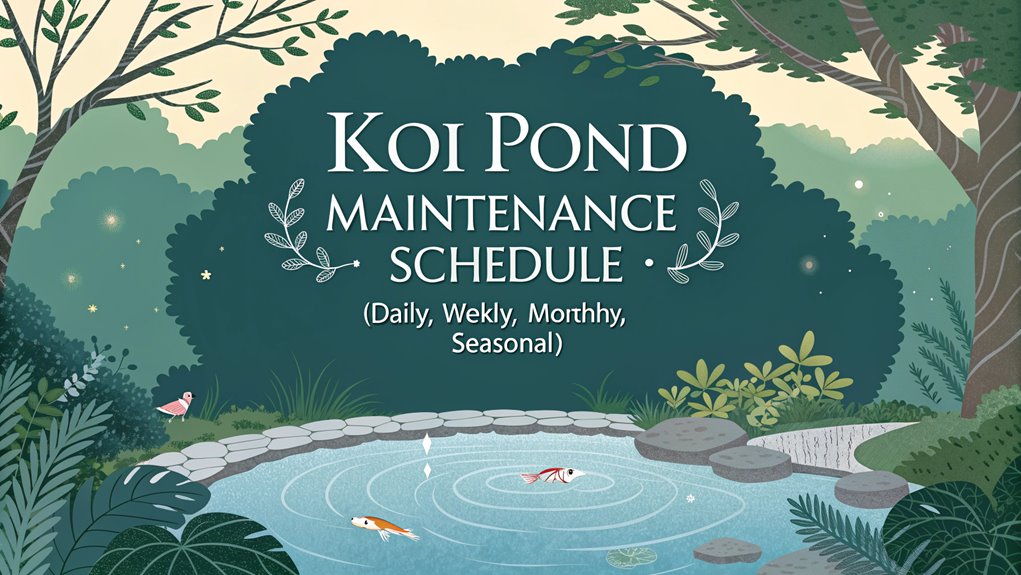To maintain your koi pond, remove debris daily, monitor koi behavior, and check water temperature with a thermometer. Conduct weekly tasks like 10% water changes, skimmer cleaning, pond vacuuming, and water quality testing. Monthly, inspect equipment and monitor ammonia, nitrites, and dissolved oxygen. Seasonally, adjust for weather: in fall, prioritize debris removal; in winter, maintain aeration; in spring and summer, increase water changes and aeration. Details on professional cleaning and maintenance follow.
TLDR
- Remove debris daily and monitor koi behavior for illness signs.
- Perform weekly 10% water changes and test water quality parameters.
- Inspect equipment monthly for clogs and test water for toxins.
- Adjust seasonal maintenance for optimal pond health and algae control.
- Engage professionals for thorough cleaning and equipment inspection quarterly.
Daily Koi Pond Care
Each day, it’s important to engage in specific tasks to maintain the health of your koi pond.
Start by removing debris, such as leaves and uneaten food, to preserve water quality and prevent nutrient build-up. This step is significant in controlling algae growth.
Monitor koi behavior closely for signs of illness or stress, which can indicate underlying health issues.
Check the water temperature with a thermometer, as fluctuations can affect koi metabolism.
Inspect the pond’s aeration and filtration systems to guarantee they’re functioning properly, as adequate oxygen levels are crucial for fish health.
While weekly testing of water quality parameters like pH and ammonia is typical, consider daily checks in warmer months for ideal results in maintaining your pond’s ecosystem.
Weekly Maintenance Tasks
A critical aspect of koi pond upkeep is adhering to a consistent weekly maintenance schedule.
Start with a 10% water change to maintain ideal water quality parameters, preventing harmful toxins’ buildup.
Clean the skimmer basket to guarantee efficient filtration, an essential component of pond maintenance.
Vacuum the pond bottom weekly to remove sludge and organic matter, promoting a healthy pond environment.
Regularly check the filtration system; while filters are cleaned every 3 to 4 months, inspect them weekly for immediate cleaning needs during high waste periods.
Test water quality parameters like pH, ammonia, nitrites, and nitrates to detect fluctuations that might harm your koi.
Don’t forget to feed the fish appropriately to keep your koi healthy and thriving.
Monthly Equipment Check and Water Quality Testing
While maintaining a koi pond, it’s vital to conduct a thorough monthly equipment check and water quality testing to guarantee the health of your aquatic ecosystem.
Begin by inspecting all pond equipment, focusing on the pond pump and filters, to confirm their proper operation and address any clogs or maintenance issues.
Perform water quality testing to evaluate key water parameters, including ammonia and nitrites, nitrates, and dissolved oxygen levels. These tests assure a stable and healthy water environment for your koi.
Monthly check-ups should also include verifying the functionality of UV filter bulbs, essential for algae control.
Regularly monitor water temperature with both floating and sinking thermometers.
Consistently record and track these findings to refine your maintenance schedule effectively.
Seasonal Adjustments for Optimal Pond Health
After completing your monthly equipment checks and water quality tests, turn your attention to the seasonal adjustments necessary for maintaining ideal pond health.
As water temperature drops in fall, prioritize debris removal and continue 10% water changes to help keep your koi healthy. This prepares the pond ecosystem for winter dormancy.
In winter, provide extra aeration and maintain an ice porthole for gas exchange, essential for preventing health issues.
Shift to spring cleaning with a 20% water change and reactivate pumps and filters when temperatures rise above 50°F.
Adjust maintenance frequency during summer by increasing aeration, performing water changes, and monitoring water quality twice weekly to prevent algae blooms.
These adjustments guarantee koi ponds remain balanced throughout the year.
Professional Pond Cleaning and Maintenance
Engaging professional pond cleaning and maintenance services can greatly boost the health and aesthetics of your koi pond.
These experts conduct thorough debris removal and equipment inspections to guarantee the best water quality. Regular deep cleaning of filters and pumps, every 3 to 4 months, is essential for maintaining efficiency.
Professional services often include extensive water quality tests, monitoring pH, ammonia, nitrates, and oxygen levels. This scientific approach helps identify potential issues early, preventing algae blooms and safeguarding fish health.
Seasonal maintenance, like winterization, protects your pond during colder months. By relying on professionals, you secure a clean and healthy environment, enhancing pond aesthetics.
Their expertise in managing complex ecosystems addresses specific challenges, promoting a balanced and thriving pond ecosystem.
Frequently Asked Questions
What Kind of Maintenance Does a Koi Pond Need?
You need to remove debris daily, change 10% water weekly, and test water quality parameters. Clean filtration systems quarterly, check UV lights monthly, and adjust seasonally for temperature changes to maintain koi pond health effectively.
How Often Does a Koi Pond Need to Be Cleaned?
You should clean your koi pond daily, removing debris to prevent algae. Weekly, perform a 10% water change and clean the skimmer. Monthly, inspect filtration. Seasonally, conduct thorough cleanings to maintain ecological balance and water quality.
What Time of Year Should I Stop Feeding My Koi?
Stop feeding your koi when water temperatures consistently fall below 50°F. Shift to wheat germ-based food weeks prior to prepare them for dormancy. Monitor temperatures closely to guarantee you’re feeding appropriately and preventing digestion issues during winter.
What to Do With a Koi Pond in the Winter?
Did you know koi metabolism drops 50% in winter? Maintain an ice porthole for gas exchange, aerate to prevent freezing, and monitor water quality monthly. Store equipment indoors and stop feeding when temperatures fall below 50°F.
Conclusion
Maintaining a koi pond might seem intimidating, but with a structured schedule, it becomes manageable and rewarding. By diligently following daily, weekly, monthly, and seasonal tasks, you guarantee a thriving ecosystem. You might worry about the time commitment, but these routines quickly become second nature, fostering a peaceful, vibrant pond. Embrace this scientific approach—it’s not just maintenance; it’s an opportunity to connect with nature and witness the fascinating behaviors of your koi in a well-balanced habitat.


